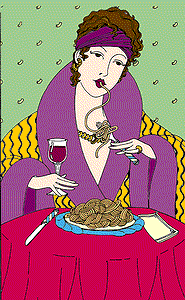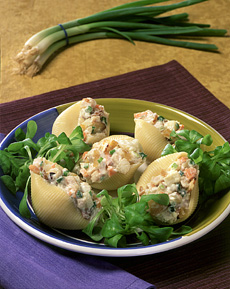The next time you’re enjoying a dish of pasta with family or friends, impress them with your vast knowledge of the subject.
 |
In 18th century England, macaroni was a synonym for perfection and excellence. That's why, for example, the feather in Yankee Doodle's cap was called “macaroni.” In fact, the word macaroni means dearest darlings in Italian.
Editor’s Note: In the 18th century, young English aristocrats returning home from a grand tour of Italy became known as “macaronis” for their foreign affectations. In the mid-eighteenth century, “macaroni” referred to an overblown hairstyle as well as to the dandy wearing it. It is the dandy to whom the songwriter refers when “Yankee Doodle stuck a feather in his cap and called it ‘macaroni.’” Doodle comes from a German word meaning “simpleton,” which was same definition that noodle had at the time. In sum, the song “Yankee Doodle” was used by the British to ridicule the American colonists, who adopted it in self-defense.
|
 |
The Chinese are on record as having eaten pasta as early as 5,000 B.C.
|
 |
In the 13th century, the Pope set quality standards for pasta.
|
 |
Tripolini or “little bows” were named to honor the Italian conquest of Tripoli in Libya.
|

|
 |
There are more than 600 pasta shapes produced worldwide.
|
 |
Top-quality pasta is made from durum wheat. According to the North Dakota Agricultural Statistics Service, about 73 percent of the durum wheat grown in the U.S. is actually grown in North Dakota. American-grown durum wheat is considered among the best in the world. The pick of the crop is earmarked for domestic use, ensuring a finished pasta product second to none in the world.
|
 |
According to Miss Manners (a.k.a. Judith Martin), a fork is the only utensil that may be used to eat spaghetti while anyone is looking.
|
 |
In Italian, fettuccine means ribbons; stelline means little stars; and capelli d’angelo means angel’s hair.
|
 |
 Contrary to popular belief, Marco Polo did not discover pasta. The ancient Italians made pasta much like we do today. Although Marco Polo wrote about eating Chinese pasta at the court of Kubla Khan, he probably didn’t introduce pasta to Italy. In fact, there’s evidence suggesting the Etruscans made pasta as early as 400 B.C. The evidence lies in a bas-relief carving in a cave about 30 miles north of Rome. The carving depicts instruments for making pasta: a rolling-out table, pastry wheel and flour bin. And further proof that Marco Polo didn’t “discover” pasta is found in the will of Ponzio Baestone, a Genoan soldier who requested “bariscella peina de macarone”—a small basket of macaroni. His will is dated 1279, 16 years before Marco Polo returned from China. Contrary to popular belief, Marco Polo did not discover pasta. The ancient Italians made pasta much like we do today. Although Marco Polo wrote about eating Chinese pasta at the court of Kubla Khan, he probably didn’t introduce pasta to Italy. In fact, there’s evidence suggesting the Etruscans made pasta as early as 400 B.C. The evidence lies in a bas-relief carving in a cave about 30 miles north of Rome. The carving depicts instruments for making pasta: a rolling-out table, pastry wheel and flour bin. And further proof that Marco Polo didn’t “discover” pasta is found in the will of Ponzio Baestone, a Genoan soldier who requested “bariscella peina de macarone”—a small basket of macaroni. His will is dated 1279, 16 years before Marco Polo returned from China.
Editor’s Note: In fact, the evidence is that the Arabs introduced pasta to Italy in the 8th century.
|
 |
Legend has it that noodles were first made by 13th century German bakers who fashioned dough into symbolic shapes such as swords, birds and stars, which were baked and served as bread.
|
 |
All pasta is made by essentially the same equipment using the same technology. In independent taste tests conducted by Consumer Reports, Cook's Illustrated and The Washington Post, U.S. pasta either was found to be superior to Italian imports, or the judges were unable to discern a difference between them.
|
 |

Thomas Jefferson is credited with introducing macaroni to the United States. It seems that he fell in love with a certain dish he sampled in Naples while serving as the U.S. Minister to France from 1785 to 1789. In fact, he promptly ordered crates of “maccheroni,” along with a pasta-making machine, sent back to the States.
Editor’s Note: However, the pasta did not spread beyond his close circle of friends. Broadscale pasta-making did not occur until the Italian immigration of the late 19th century.
|
 |
 The first American pasta factory was opened in Brooklyn, New York, in 1848, by a Frenchman named Antoine Zerega. Mr. Zerega managed the entire operation with just one horse in his basement to power the machinery. To dry his spaghetti, he placed strands of the pasta on the roof in the sunshine. The first American pasta factory was opened in Brooklyn, New York, in 1848, by a Frenchman named Antoine Zerega. Mr. Zerega managed the entire operation with just one horse in his basement to power the machinery. To dry his spaghetti, he placed strands of the pasta on the roof in the sunshine.
|
 |
To cook one billion pounds of pasta, you would need 2,021,452,000 gallons of water—enough to fill nearly 75,000 Olympic-size swimming pools.
|
 |

One billion pounds of pasta is about 212,595 miles of 16-ounce packages of spaghetti stacked end-to-end—enough to circle the earth's equator nearly nine times.
|
 |
Pasta is one of the foods kids most frequently eat at home, according to research conducted by Land O’Lakes. Seventeen percent eat spaghetti while 16 percent eat macaroni and cheese. Statistics from the NPD Group, a custom research group, show that kids eat 62 pounds of pasta each year—more than any other age group.
|
 |
Consumers enjoy pasta for dinner more than 40 times a year (approximately once a week), with dry pasta as their favorite form, according to Harry Balzer, NPD Group, Chicago, IL.
|
 |

Christopher Columbus, one of Italy’s most famous pastaphiles, was born in October, which is now National Pasta Month.
|
 |
During the 1980s, macaroni, which was traditionally considered a “blue-collar” down-home meal, was transformed into the more upscale “pasta.” As more and more people began to have fun with pasta and romanticize it throughout the 1960s and 1970s, its image began to change along with its name.
|
 |
The word “pasta” comes from the Italian word for paste, meaning a combination of flour and water. It includes the many forms of spaghetti, macaroni and egg noodles. The term pasta has always been used on Italian restaurant menus to encompass all the various pasta offerings.
|
 |
 Pasta existed for thousands of years before anyone ever thought to put tomato sauce on it. The Spanish explorer Cortez brought tomatoes back to Europe from Mexico in 1519. Even then, almost 200 years passed before spaghetti with tomato sauce made its way into Italian kitchens. Pasta existed for thousands of years before anyone ever thought to put tomato sauce on it. The Spanish explorer Cortez brought tomatoes back to Europe from Mexico in 1519. Even then, almost 200 years passed before spaghetti with tomato sauce made its way into Italian kitchens.
Editor’s Note: That’s because tomatoes are a member of the poisonous nightshade family, and Europeans were afraid to eat them. They used them as houseplants.
|
 |
Egg noodles contain egg; almost all other dry pasta shapes do not. By federal law, a noodle must contain 5.5 percent egg solids to be called a noodle. So without egg, a noodle really isn’t a noodle.
|
 |
One cup of cooked spaghetti provides about 200 calories, 40 grams of carbohydrates, less than one gram of total fat, no cholesterol and only one gram of sodium (when cooked without salt).
|
 |
 Speaking of spaghetti...and meatballs: the Italians only ate meat a few times a month. So, when they came to America, where meat was so plentiful, they incorporated meat into their cooking more often, making meatballs an American invention. Speaking of spaghetti...and meatballs: the Italians only ate meat a few times a month. So, when they came to America, where meat was so plentiful, they incorporated meat into their cooking more often, making meatballs an American invention.
|
 |
Cooked al dente literally means “to the tooth,” which is how to test pasta to see if it is properly cooked. The pasta should be a bit firm, offering some resistance to the tooth, but tender.
|
 |
Actor Leonardo DiCaprio’s favorite food is said to be pasta, according to a Wall Street Journal article. |
© Copyright 2005 National Pasta Association. All rights reserved.






 Contrary to popular belief, Marco Polo did not discover pasta. The ancient Italians made pasta much like we do today. Although Marco Polo wrote about eating Chinese pasta at the court of Kubla Khan, he probably didn’t introduce pasta to Italy. In fact, there’s evidence suggesting the Etruscans made pasta as early as 400 B.C. The evidence lies in a bas-relief carving in a cave about 30 miles north of Rome. The carving depicts instruments for making pasta: a rolling-out table, pastry wheel and flour bin. And further proof that Marco Polo didn’t “discover” pasta is found in the will of Ponzio Baestone, a Genoan soldier who requested “bariscella peina de macarone”—a small basket of macaroni. His will is dated 1279, 16 years before Marco Polo returned from China.
Contrary to popular belief, Marco Polo did not discover pasta. The ancient Italians made pasta much like we do today. Although Marco Polo wrote about eating Chinese pasta at the court of Kubla Khan, he probably didn’t introduce pasta to Italy. In fact, there’s evidence suggesting the Etruscans made pasta as early as 400 B.C. The evidence lies in a bas-relief carving in a cave about 30 miles north of Rome. The carving depicts instruments for making pasta: a rolling-out table, pastry wheel and flour bin. And further proof that Marco Polo didn’t “discover” pasta is found in the will of Ponzio Baestone, a Genoan soldier who requested “bariscella peina de macarone”—a small basket of macaroni. His will is dated 1279, 16 years before Marco Polo returned from China.
 The first American pasta factory was opened in Brooklyn, New York, in 1848, by a Frenchman named Antoine Zerega. Mr. Zerega managed the entire operation with just one horse in his basement to power the machinery. To dry his spaghetti, he placed strands of the pasta on the roof in the sunshine.
The first American pasta factory was opened in Brooklyn, New York, in 1848, by a Frenchman named Antoine Zerega. Mr. Zerega managed the entire operation with just one horse in his basement to power the machinery. To dry his spaghetti, he placed strands of the pasta on the roof in the sunshine.

 Speaking of spaghetti...and meatballs: the Italians only ate meat a few times a month. So, when they came to America, where meat was so plentiful, they incorporated meat into their cooking more often, making meatballs an American invention.
Speaking of spaghetti...and meatballs: the Italians only ate meat a few times a month. So, when they came to America, where meat was so plentiful, they incorporated meat into their cooking more often, making meatballs an American invention.